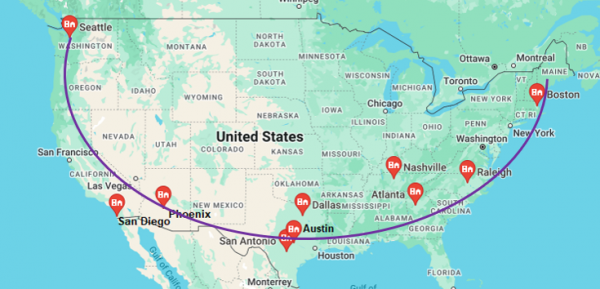Still Smiling
John Greenman
(Hay una versión en español de este artículo aquí.)
In recent years commercial real estate investors have come to use the expression “the Smile markets” to describe the high growth cities of the southern half of the United States that trace a figure like a smile across the country.

The Smile includes the Sun Belt and extends up both coasts to take in markets not always sunny.
The Smile markets continue to be most attractive to investors, as is shown by the latest edition of the Urban Land Institute’s Emerging Trends report, which ranks 80 metro areas across the top 10 U.S. markets for 2024:
- Nashville
- Phoenix
- Dallas-Fort Worth
- Atlanta
- Austin
- San Diego
- Boston
- San Antonio
- Raleigh-Durham
- Seattle
For all the tumult that the pandemic brought to real estate, the top-rated markets have scarcely changed in recent years. For the third year in a row, Nashville is ranked number 1. Never before had a city stayed top ranked for three years in a row. Nashville sits astride the dynamic “Mid-South” corridor that runs east to west on Interstate 40 along with Raleigh-Durham, #9 on the list. Like Austin, Nashville is a “lifestyle” city—music matters, and tourism along with health care and technology are strong economic drivers.
Also close to the I-40 corridor is the financial center of Charlotte, North Carolina, ranked #13 this year.
Other hardy perennials in the Top Ten are Atlanta (#4) and the major cities of the Texas Triangle, namely DFW at #3, Austin at #5, and San Antonio, which has risen to #8 after many years much further down the list. Houston just missed the Top Ten, coming in at #11 for 2024.
Surprisingly, Phoenix rose to #2. In investors’ minds, the perils of extreme summer heat are offset by the city’s still-strong in-migration and, compared with neighbor California, reasonable cost structure.
On the West Coast, San Diego completes the western end of the Smile at #6. Everyone says they’d live in San Diego if they could.
Seattle comes in at #10 as the concentration of tech giants makes investors willing to put up with rainy weather.
Boston, #7 this year, is the sole older (“legacy-market”) city to continue to consistently appear in the Top Ten, while the charms of other once sought-after “gateway” cities such as Washington D.C. (#23), Manhattan (#31), and San Francisco (#54) have slid in investor preferences. Boston somehow has found the formula to offset high costs with a sky-high–value metro economy and could be a model for other legacy markets.
Can anything reverse the long-running migration of people and jobs from the Northeast and the Midwest to the sunny and more business-friendly cities of the Smile? Extreme weather, for example, at least along both coasts and in Phoenix?
Florida cities were all rated lower this year than in years past, likely because of climate concerns. But Nashville is safely inland!

